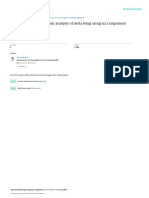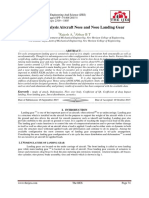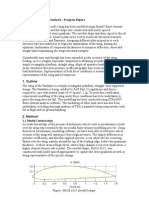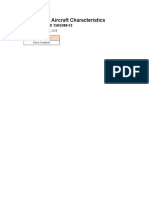Ijciet 08 05 093
Ijciet 08 05 093
Uploaded by
mikhaelkjmCopyright:
Available Formats
Ijciet 08 05 093
Ijciet 08 05 093
Uploaded by
mikhaelkjmOriginal Title
Copyright
Available Formats
Share this document
Did you find this document useful?
Is this content inappropriate?
Copyright:
Available Formats
Ijciet 08 05 093
Ijciet 08 05 093
Uploaded by
mikhaelkjmCopyright:
Available Formats
International Journal of Civil Engineering and Technology (IJCIET)
Volume 8, Issue 5, May 2017, pp.842–850, Article ID: IJCIET_08_05_093
Available online at http://iaeme.com/Home/issue/IJCIET?Volume=8&Issue=5
ISSN Print: 0976-6308 and ISSN Online: 0976-6316
© IAEME Publication Scopus Indexed
DESIGN AND ANALYSIS OF WINGLET
Alka Sawale
Department of Aeronautical Engineering, MLR Institute of Technology, Hyderabad, India.
MD Khaleel
Department of Aeronautical Engineering, MLR Institute of Technology, Hyderabad, India.
S. Jaswanth
Student, Department of Aeronautical Engineering, MLR Institute of Technology Hyderabad,
India.
ABSTRACT
The project is focused on the modeling and analysis of winglet of aircraft. In
aerodynamic engineering, drag reduction is a big challenge. To reduce drag a device
called winglet which is placed vertically at set of angle on the end of aircraft wing.
Winglet design will reduce the fuel consuming by reducing the aircraft drag and
makes the aircraft more stable during flight, also it will give the aircraft engine
longer life by reducing the load on the engine thrust. The aim is to design and
simulate a model of winglet for aircraft by using software such as CATIA -V5 which is
used to construct the winglet models and ANSYS is used to test and simulate the
winglet model. With winglet and without winglet is analyzed by changing the cant
angles, results are compared and plotted. Winglets are an important part of an
aircraft because it lowers the amount of drag and increases the fuel efficiency by
using less energy by reducing wing-tip vortices. Winglet played very important role in
improving the aircraft performance.
Key words: Winglet, wingtip vortices, Comparison
Cite this Article: Alka Sawale, MD Khaleel and S. Jaswanth Design and Analysis of
Winglet. International Journal of Civil Engineering and Technology, 8(5), 2017, pp.
842–850.
http://iaeme.com/Home/issue/IJCIET?Volume=8&Issue=5
1. INTRODUCTION
A winglet is a device used to improve the efficiency of aircraft by lowering the lift induced
drag caused by wingtip vortices. It is a vertical or angled extension at the tips of each wing.
Winglets improve efficiency by diffusing the shed wingtip vortex, which in turn reduces the
drag due to lift and improves the wing’s lift over drag ratio Winglets increase the effective
aspect ratio of a wing without adding greatly to the structural stress and hence necessary
weight of its structure.
http://iaeme.com/Home/journal/IJCIET 842 editor@iaeme.com
Alka Sawale, MD Khaleel and S. Jaswanth
Winglets increase an aircraft's operating efficiency by reducing what is called induced
drag at the tips of the wings. An aircraft's wing is shaped to generate negative pressure on the
upper surface and positive pressure on the lower surface as the aircraft moves forward. This
unequal pressure creates lift across the upper surface and the aircraft is able to leave the
ground and fly.
Winglets, which are airfoils operating just like a sailboat tacking upwind, produce a
forward thrust inside the circulation field of the vortices and reduce their strength. Weaker
vortices mean less drag at the wingtips and lift is restored. Improved wing efficiency
translates to more payloads, reduced fuel consumption, and a longer cruising range that can
allow an air carrier to expand routes and destinations.
2. MODELING
CATIA means (Computer Aided Three-Dimensional Interactive Application) started as an in-
house development in 1977 by French aircraft manufacturer Avions Marcel Dassault, at that
time customer of the CAD/CAM CAD software to develop Dassault's Mirage fighter jet. It
was later adopted in the aerospace, automotive, shipbuilding, and other industries. Initially
named CATI (Conception Assistee Tri dimensional Interactive – French for Interactive Aided
Three-dimensional Design), it was renamed CATIA in 1981 when Dassault created a
subsidiary to develop and sell the software and signed a non-exclusive distribution agreement
with IBM.
2.1 Design of Winglet
Goal: Generate enough lift while maintaining the lowest possible drag, Should not stall
before wing during low speed flight, and the Geometry driven by aerodynamic
characteristics of the airfoil.
Chord Distribution: If the Chord Distribution is too small then the airfoil will require a large
lift coefficient and when it is too big then the high winglet loading causes outboard
section of wing to stall prematurely.
The Elliptical plan form will help with load distribution over a large range of flight
regimes.
Winglet Height: The Height of the Winglet is determined by the optimal induced drag and
profile drag relationship.
Twist/Sweep: The Twist /Sweep angles have similar effects on the winglet and They Tailor
the load distribution.
Toe Angle: It controls overall loading on winglet, Effects the load distribution on main wing
and it is only optimum for one flight condition.
Figure 1 Geometric quantities used to define a winglet
http://iaeme.com/Home/journal/IJCIET 843 editor@iaeme.com
Design and Analysis of Winglet
3. WING SELECTION
3.1. Wing Dimensions
• Tapered wing
• Chord length : 7000mm
• span : 35800mm
3.2. Type of winglet
Blended winglet
Figure 2 Winglet parts
3.3. Geometry of Winglet
• Airfoil : NACA 2412
• Chord distribution : Root chord - 1600mm; Tip chord - 864mm
• cant angle : 15 deg
• sweep angle : 25deg
3.4. Wing Modeling
3.4.1. Winglet at 150
Figure 3 winglet at cant angle 150 Figure 4 3D view winglet at cant angle 150
http://iaeme.com/Home/journal/IJCIET 844 editor@iaeme.com
Alka Sawale, MD Khaleel and S. Jaswanth
3.4.2. Winglet at 300
Figure 5 winglet at cant angle 300
3.4.3. Winglet at 600
Figure 6 winglet at cant angle 600
3.5. Without Winglet
The wing without winglet is designed by taking the above model and removing the winglet
Figure 7 Without Winglet
http://iaeme.com/Home/journal/IJCIET 845 editor@iaeme.com
Design and Analysis of Winglet
4. ANALYSIS
ANSYS provides a comprehensive suite of computational fluid dynamics software for
modeling fluid flow and other related physical phenomena. It offers unparalleled fluid flow
analysis capabilities, providing all the tools needed to design and optimize new fluids
equipment and to troubleshoot existing installations. The primary ANSYS products in the
fluids area are ANSYS Fluent and ANSYS CFX.
4.1 Meshing
4.1.1. Mesh Procedure
The mesh details of the as follows:
• Element type : Unstructured Tetra elements
• Total elements : 2757733
• Total nodes : 491323
• Geometry
• physics preference: CFD
• Solver Preference: Fluent
• Select all the surface required to carry the mesh
Figure 9 Domain with winglet Figure 10 Mesh
Apply front geometry for two sides as air inlet and air outlet as show in fig., after meshing
the selection of boundary conditions is made. The selected boundary conditions are
represented in the Table below.
Table 1 Boundary conditions for wing with winglet
component Boundary type
Inflow Velocity Boundary
Outflow Pressure Outlet
Aircraft Wall
Far field Slip
Symmetry Symmetry option
http://iaeme.com/Home/journal/IJCIET 846 editor@iaeme.com
Alka Sawale, MD Khaleel and S. Jaswanth
5. RESULTS
These are the ANSYS result .For wing with winglet at different angles
5.1 Winglet at Cant angle 150
5.1.1 Velocity: 180 m/s
Figure 11 Contour of Pressure
5.1.2. Velocity: 220 m/s
Figure 12 Contours of Pressure
http://iaeme.com/Home/journal/IJCIET 847 editor@iaeme.com
Design and Analysis of Winglet
5.2. Winglet at Cant angle 450
5.2.1. Velocity: 180 m/s
Figure 13 Contours of Pressure
5.2.2. Velocity: 220 m/s
Figure 14 Contours of pressure
The calculations are calculated for the induced drag, which were done using the Excel sheet
for the results obtained from the ANSYS software 15.0. The results are calculated to study
the changes of induced drag for the NACA 2412 airfoil for the different Cant angles for a
same winglet of the airfoil. The tabular column below is drawn for the assistance to calculate
the induced drag of the airfoil. The table has different mach. no ranging from 0.5 and 0.6. For
the parameters which are used in the calculation for induced drag such as Lift, Coefficient of
lift, Drag, Coefficient of drag, lift to drag ratio, and for different cant angles.
http://iaeme.com/Home/journal/IJCIET 848 editor@iaeme.com
Alka Sawale, MD Khaleel and S. Jaswanth
Table 2 Mach no and parameters
M 0.5 0.6
V 180 m/s 220 m/s
Cant Angle w/o 15 45 w/o 15 45
Lift 9.11E+06 9.04E+06 9.04+06 1.35E+07 1.32E+07 1.32E+07
CL 0.8215648 0.8160285 0.815757 0.815603838 0.797604 0.797321
Drag 569388.5 571508.9 587733.9 844153.1875 871575.9 947338.8
CD 0.051374 0.051566 0.05303 0.076166243 0.078641 0.085476
L/D 15.991598 15.82488 15.38292 10.70820617 10.14241 9.327954
M=0.5
0.0336 With Winglet
0.0335
Without Winglet
0.0334
CDi
0.0333
0.0332
0.0331
0.033
0 20 40 60 80
CANT ANGLE
The graph is plotted for KC_L^2 and Cant angles
M=0.6
0.0335 Without
Winglet
0.033
With Winglet
0.0325
CDi
0.032
0.0315
0.031
0 20 40 60 80
CANT ANGLE
The graph is plotted for KC_L^2 and Cant angles
http://iaeme.com/Home/journal/IJCIET 849 editor@iaeme.com
Design and Analysis of Winglet
6. CONCLUSION
Based on the CFD results for NACA 2412 and swept back when used blended winglets we
observed 4 to 10 percent reduction for Mach regime 0.5 and 0.6, however we observed the
overall aerodynamic efficiency and change in lift production for both with and without
winglets are minimum. We observed induced drag reduced 10 to 15 percent linearly for 50
percent we observe slight increase in L/D compared to its prior to its preceding cant angles
(that at 50 deg). However wing configuration with winglets has less induced drag compared
to wings without winglets. Further work has to be done on other winglets such as sharklets,
spoired winglets etc and compare those results with these results and with theirs and
evaluated best winglets for certain configuration and flow regime. Similarly other type of
wing configuration and airfoil need to be studied and understood. Especially all the above
activities had to be carried out close to transonic and supersonic regimes where necessities of
winglets are much required.
REFERENCES
[1] Khamis Ali Al Sidari, G.R.Rameshkumar, “Design of Winglet Device for Aircraft”, in
International Journal of Multidisciplinary Sciences and Engineering, vol.7 No.1, 2016.
[2] A. Rajesh, Praveen A S, and Dr. M S Ganesha Prasad, “Design and Analysis of UCAV
Wing with a without winglet by varying the Cant Angle”, IJERT, vol. 4, issue 5, pp. 351–
354, 2015.
[3] Alekhya Bojja, Parthasarathy Garre, “Analysis on Reducing the Induced Drag Using the
Winglet at the Wingtip”, IJERT, vol.2,Issue No.12, 2013. .
[4] M Dinesh, Prem Kumar P S, J S Rao, Dr. C Senthil Kumar, “Performance Analysis of
Winglets using CFD Simulation”, Altair Technology Conference, 2013.
[5] R.T. Whitcomb, "A Design Approach and Selected Wing-Tunnel Result at High Subsonic
Speed for Wing-Tip Mounted Winglets," NASA TN D-8260, 1976, USA.
[6] R. T. Jones and T. A. Lasinski, "Effect of Winglets on the Induced Drag of Ideal Wing
Shapes," NASA TM-81230, 1980, USA.
[7] D. P. Raymer, "Aircraft design: a conceptual approach" American Institute of Aeronautics
and Astronautics", 1999, USA.
[8] Dr. PARCHURE Narendra P. and Dr. SOMAN Pallavi Y. Disaster Following Natural
Events-Prevention and Management of Disaster. International Journal of Management,
7(1), 2016, pp. 01-14.
[9] Kolli Ramesh and Mr. A. Ashok Kumar. Design of 8-Bit Current Steering Digital To
Analog Converter Using Full Swing GDI Logic, International Journal of Electronics and
Communication Engineering & Technology, 6(9), 2015, pp. 97-106.
[10] Abhishek. G and Dr. C.B. Senthikumar, Enhancement of Intrapreneurs in the Growing
Corporate Organizations. International Journal of Management, 7(6), 2016, pp. 156–163.
[11] Wendrila Biswas, Medical Tourism – A Growing and Potential Segment in Indian
Scenario. Journal of Management, 3(1), 2016, pp. 19–26.
[12] D. McLean, "Wingtip Devices: What they Do and How They Do it," presented at the
Boeing Performance and Flight Operations Engineering Conference, 2005.
http://iaeme.com/Home/journal/IJCIET 850 editor@iaeme.com
You might also like
- Modeling and CFD Analysis of Flow Over Aircraft Split Winglet and Blended WingletNo ratings yetModeling and CFD Analysis of Flow Over Aircraft Split Winglet and Blended Winglet6 pages
- International Journal of Research in Aeronautical and Mechanical EngineeringNo ratings yetInternational Journal of Research in Aeronautical and Mechanical Engineering19 pages
- IJUSEng - Aerodynamic Design of Delta UAVNo ratings yetIJUSEng - Aerodynamic Design of Delta UAV15 pages
- Using The Winglet Toe and Twist Angle To Improve WNo ratings yetUsing The Winglet Toe and Twist Angle To Improve W13 pages
- An Experimental Investigation On The Aerodynamic Characteristics of NACA 4412 With WingletsNo ratings yetAn Experimental Investigation On The Aerodynamic Characteristics of NACA 4412 With Winglets10 pages
- Drag_Reduction_in_Aircraft_Model_using_Elliptical_No ratings yetDrag_Reduction_in_Aircraft_Model_using_Elliptical_9 pages
- APR Performance APR004 Wing Profile CFD AnalysisNo ratings yetAPR Performance APR004 Wing Profile CFD Analysis11 pages
- Aircraft Design Project Eight Seater Short Range Business Jet Aircraft89% (9)Aircraft Design Project Eight Seater Short Range Business Jet Aircraft119 pages
- CFD Analysis of Flap of Airplane Wing Span at Subsonic SpeedNo ratings yetCFD Analysis of Flap of Airplane Wing Span at Subsonic Speed7 pages
- Effect of Spoiler Position On AerodynamiNo ratings yetEffect of Spoiler Position On Aerodynami6 pages
- Experimental Aerodynamic Analysis of Delta WingNo ratings yetExperimental Aerodynamic Analysis of Delta Wing9 pages
- Control of Wingtip Vortices by Using Different Wingtip ConfigurationsNo ratings yetControl of Wingtip Vortices by Using Different Wingtip Configurations2 pages
- Design and Finite Element Analysis of Ai PDFNo ratings yetDesign and Finite Element Analysis of Ai PDF7 pages
- Numerical Investigation of Wing Tip Modification (Autosaved)No ratings yetNumerical Investigation of Wing Tip Modification (Autosaved)29 pages
- Performance Analysis of High Wing For A Micro Class Unmanned Aerial VehicleNo ratings yetPerformance Analysis of High Wing For A Micro Class Unmanned Aerial Vehicle9 pages
- CFD Analysis of NACA 0012 Aerofoils: Examining The Impact of Varied Angles of Attack On Lift and Drag CoefficientsNo ratings yetCFD Analysis of NACA 0012 Aerofoils: Examining The Impact of Varied Angles of Attack On Lift and Drag Coefficients24 pages
- Aerodynamics of Winglet: A Computational Fluid Dynamics StudyNo ratings yetAerodynamics of Winglet: A Computational Fluid Dynamics Study16 pages
- Structural and Modal Analysis of A300 Wing PDF100% (2)Structural and Modal Analysis of A300 Wing PDF59 pages
- Experimental Aerodynamic Analysis of Delta WingNo ratings yetExperimental Aerodynamic Analysis of Delta Wing8 pages
- CFD Analysis and Comparision of Spiroid and Dual Feather WingletsNo ratings yetCFD Analysis and Comparision of Spiroid and Dual Feather Winglets5 pages
- Design and Analysis Aircraft Nose and Nose Landing Gear PDFNo ratings yetDesign and Analysis Aircraft Nose and Nose Landing Gear PDF8 pages
- Computational Analysis of The Aerodynamic Performance of NACA 4412 and NACA 23012 AirfoilsNo ratings yetComputational Analysis of The Aerodynamic Performance of NACA 4412 and NACA 23012 Airfoils11 pages
- Design of Aerodynamic of An Airplane WingsNo ratings yetDesign of Aerodynamic of An Airplane Wings6 pages
- Seminar Report On Aerofoil NACA Designation in CFD100% (1)Seminar Report On Aerofoil NACA Designation in CFD23 pages
- Design and Finite Element Analysis of Aircraft Wing Using Ribs and SparsNo ratings yetDesign and Finite Element Analysis of Aircraft Wing Using Ribs and Spars8 pages
- Aerodynamic Analysis of Dimple Effect On Aircraft WingNo ratings yetAerodynamic Analysis of Dimple Effect On Aircraft Wing4 pages
- Numerical Analysis of Aircraft Nose Landing Gear Using FEA: Jithin Malayil Jacob, Dr. Evangelia Ganniari PapageorgiouNo ratings yetNumerical Analysis of Aircraft Nose Landing Gear Using FEA: Jithin Malayil Jacob, Dr. Evangelia Ganniari Papageorgiou9 pages
- Design Project of Four Hundred Seater Twin Engine Passenger AircraftNo ratings yetDesign Project of Four Hundred Seater Twin Engine Passenger Aircraft67 pages
- Aerodynamics of Winglet: A Computational Fluid Dynamics StudyNo ratings yetAerodynamics of Winglet: A Computational Fluid Dynamics Study17 pages
- Modeling and Analysis of Ribs and Spar of An Aeroplane Wing: Gadi Pradeep Reddy K.Ajaya Kumar ReddyNo ratings yetModeling and Analysis of Ribs and Spar of An Aeroplane Wing: Gadi Pradeep Reddy K.Ajaya Kumar Reddy6 pages
- Small Unmanned Fixed-wing Aircraft Design: A Practical ApproachFrom EverandSmall Unmanned Fixed-wing Aircraft Design: A Practical ApproachNo ratings yet
- Design of 300 Seated Long Range Aircraft: Aswath J Hariharan L Navinkumar V (19101006) (19101015) (19101025)No ratings yetDesign of 300 Seated Long Range Aircraft: Aswath J Hariharan L Navinkumar V (19101006) (19101015) (19101025)96 pages
- Factors Lift Drag. Foilsim Program: Top ViewNo ratings yetFactors Lift Drag. Foilsim Program: Top View2 pages
- Numerical Method of Estimating and Optimizing Supersonic Aerodynamic Characteristics of Arbitrary Planform WingsNo ratings yetNumerical Method of Estimating and Optimizing Supersonic Aerodynamic Characteristics of Arbitrary Planform Wings5 pages
- Combination Gliders Harnesses Rucksacks Niviuk Paragliders enNo ratings yetCombination Gliders Harnesses Rucksacks Niviuk Paragliders en23 pages
- The Design and Construction of Flying Model AircraftFrom EverandThe Design and Construction of Flying Model Aircraft
- Modeling and CFD Analysis of Flow Over Aircraft Split Winglet and Blended WingletModeling and CFD Analysis of Flow Over Aircraft Split Winglet and Blended Winglet
- International Journal of Research in Aeronautical and Mechanical EngineeringInternational Journal of Research in Aeronautical and Mechanical Engineering
- Using The Winglet Toe and Twist Angle To Improve WUsing The Winglet Toe and Twist Angle To Improve W
- An Experimental Investigation On The Aerodynamic Characteristics of NACA 4412 With WingletsAn Experimental Investigation On The Aerodynamic Characteristics of NACA 4412 With Winglets
- Drag_Reduction_in_Aircraft_Model_using_Elliptical_Drag_Reduction_in_Aircraft_Model_using_Elliptical_
- Aircraft Design Project Eight Seater Short Range Business Jet AircraftAircraft Design Project Eight Seater Short Range Business Jet Aircraft
- CFD Analysis of Flap of Airplane Wing Span at Subsonic SpeedCFD Analysis of Flap of Airplane Wing Span at Subsonic Speed
- Control of Wingtip Vortices by Using Different Wingtip ConfigurationsControl of Wingtip Vortices by Using Different Wingtip Configurations
- Numerical Investigation of Wing Tip Modification (Autosaved)Numerical Investigation of Wing Tip Modification (Autosaved)
- Performance Analysis of High Wing For A Micro Class Unmanned Aerial VehiclePerformance Analysis of High Wing For A Micro Class Unmanned Aerial Vehicle
- CFD Analysis of NACA 0012 Aerofoils: Examining The Impact of Varied Angles of Attack On Lift and Drag CoefficientsCFD Analysis of NACA 0012 Aerofoils: Examining The Impact of Varied Angles of Attack On Lift and Drag Coefficients
- Aerodynamics of Winglet: A Computational Fluid Dynamics StudyAerodynamics of Winglet: A Computational Fluid Dynamics Study
- CFD Analysis and Comparision of Spiroid and Dual Feather WingletsCFD Analysis and Comparision of Spiroid and Dual Feather Winglets
- Design and Analysis Aircraft Nose and Nose Landing Gear PDFDesign and Analysis Aircraft Nose and Nose Landing Gear PDF
- Computational Analysis of The Aerodynamic Performance of NACA 4412 and NACA 23012 AirfoilsComputational Analysis of The Aerodynamic Performance of NACA 4412 and NACA 23012 Airfoils
- Seminar Report On Aerofoil NACA Designation in CFDSeminar Report On Aerofoil NACA Designation in CFD
- Design and Finite Element Analysis of Aircraft Wing Using Ribs and SparsDesign and Finite Element Analysis of Aircraft Wing Using Ribs and Spars
- Aerodynamic Analysis of Dimple Effect On Aircraft WingAerodynamic Analysis of Dimple Effect On Aircraft Wing
- Numerical Analysis of Aircraft Nose Landing Gear Using FEA: Jithin Malayil Jacob, Dr. Evangelia Ganniari PapageorgiouNumerical Analysis of Aircraft Nose Landing Gear Using FEA: Jithin Malayil Jacob, Dr. Evangelia Ganniari Papageorgiou
- Design Project of Four Hundred Seater Twin Engine Passenger AircraftDesign Project of Four Hundred Seater Twin Engine Passenger Aircraft
- Aerodynamics of Winglet: A Computational Fluid Dynamics StudyAerodynamics of Winglet: A Computational Fluid Dynamics Study
- Modeling and Analysis of Ribs and Spar of An Aeroplane Wing: Gadi Pradeep Reddy K.Ajaya Kumar ReddyModeling and Analysis of Ribs and Spar of An Aeroplane Wing: Gadi Pradeep Reddy K.Ajaya Kumar Reddy
- Small Unmanned Fixed-wing Aircraft Design: A Practical ApproachFrom EverandSmall Unmanned Fixed-wing Aircraft Design: A Practical Approach
- Design of 300 Seated Long Range Aircraft: Aswath J Hariharan L Navinkumar V (19101006) (19101015) (19101025)Design of 300 Seated Long Range Aircraft: Aswath J Hariharan L Navinkumar V (19101006) (19101015) (19101025)
- Numerical Method of Estimating and Optimizing Supersonic Aerodynamic Characteristics of Arbitrary Planform WingsNumerical Method of Estimating and Optimizing Supersonic Aerodynamic Characteristics of Arbitrary Planform Wings
- Combination Gliders Harnesses Rucksacks Niviuk Paragliders enCombination Gliders Harnesses Rucksacks Niviuk Paragliders en

























































































